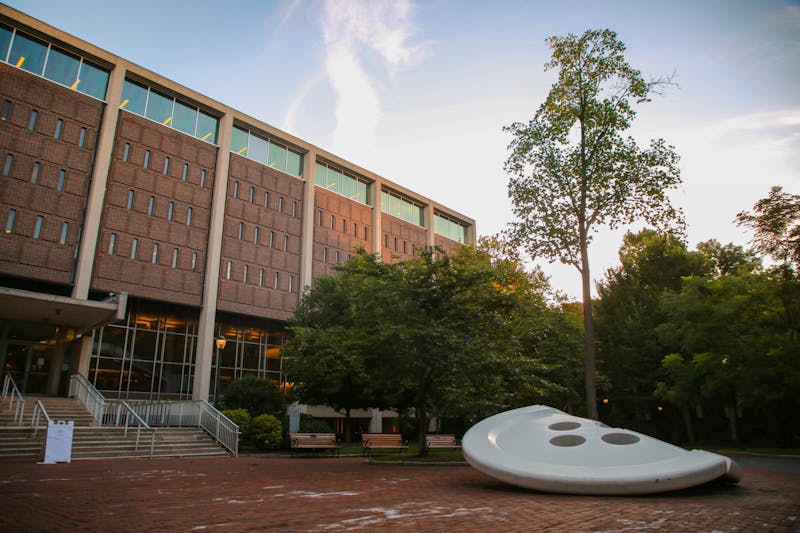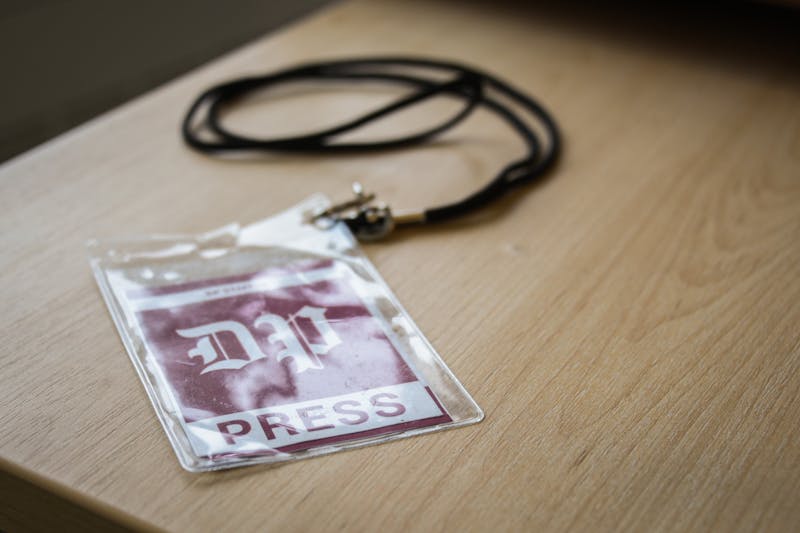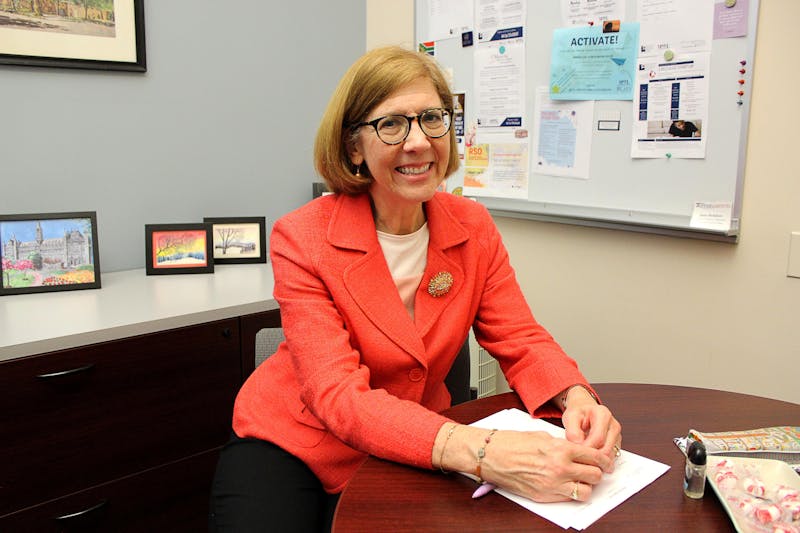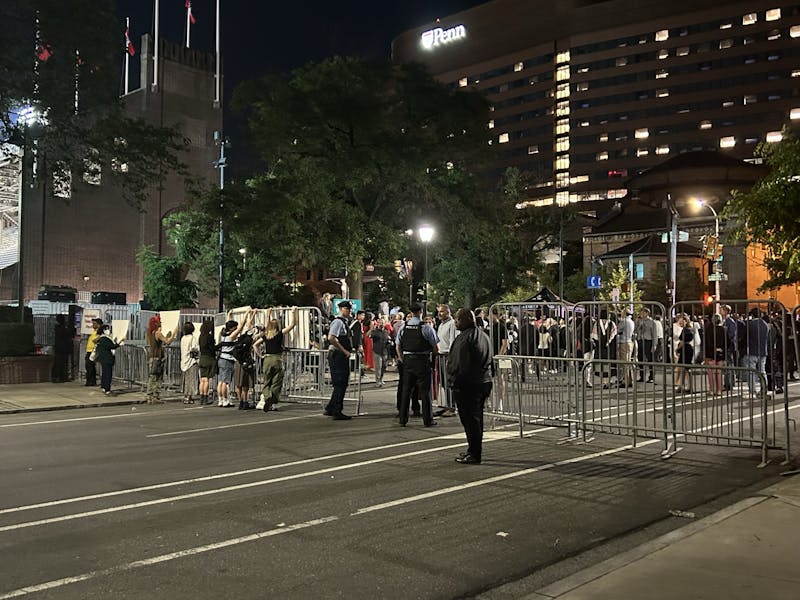
Students involved with the Penn & Slavery Project are looking to widen the impact of their research this upcoming school year.
Credit: Kylie CooperAfter the Penn & Slavery Project’s annual research presentations this past May, members of the project are looking forward to the 2024-25 academic year and opportunities to expand the project’s reach, which was recently supported anew by funding granted by Provost John Jackson Jr.’s office.
First formed in the fall of 2017, the Penn & Slavery Project is a student-driven project that researches the University’s historical ties to slavery and the slave trade. Students and faculty affiliated with the P&SP spoke with The Daily Pennsylvanian about their aspirations for the project’s future.
Research presentations
Penn history professor Kathleen Brown has guided the project since its inception and teaches the course AFRC/HIST 3173: “Penn Slavery Project Research Seminar.” In May, students in the course presented their research findings in an end-of-semester showcase. A common theme throughout the students’ research was the impact of the Perelman School of Medicine and its alumni on the development of racist science.
“It’s so beautiful to see amazing research being conducted, and these kids are just taking it so seriously,” rising sixth-year history graduate student VanJessica Gladney, one of P&SP's original researchers, told the DP.
Rising College senior Ethan Moses said that the “student-focused” nature of the course meant he could start doing archival research within the first couple of weeks. His project explored the impact of Samuel Morton — who received his medical degree from and taught anatomy at Penn — and his ideas of medical racism on the University’s medical curriculum.
“Going [to the archives] that early on, it allows you to get some direction of where you want to go,” Moses said.
Although there were only six students in the course this semester, 2024 College graduate Samah Sharmin said that the small size of the class allowed for a “collaborative learning environment.”
Additionally, she noted that the independent nature of the class allowed everyone to pursue topics of their choosing. For her, that meant examining the impact of Penn-educated physicians in the American South in the 19th century.
“I think we each were able to find a project within the topic of Penn and slavery that really interested us, but at the same time being trained in historical methods of research and archival work,” Sharmin said.
Both Sharmin and Moses said they appreciated the student-driven aspect of the work and that the University should do more to support the expansion of P&SP’s reach in the Penn and Philadelphia communities.
“If we continue to have the Penn & Slavery Project be so insular and only focused on student research and undergrad research … that perpetuates the same systems, the same inequitable power dynamic that the project is supposed to investigate,” Sharmin said. “So it’s pretty hypocritical.”
Sharmin continues to work with the P&SP throughout the summer to expand the project’s reach by revamping its website, which has not yet been updated with the latest student research.
Funding Approved
The DP previously reported that Brown requested funding from Jackson’s office in the summer of 2023 — an inquiry that went unanswered until April of this year. According to an email sent by Brown to various members of the Penn community and obtained by the DP, the Office of the Provost granted the P&SP $15,000 in funding and two years of renewable funding at $4,000 per year.
This is the first time the project has received support from the upper levels of Penn administration since at least summer 2022, when former Penn President Liz Magill took office. Previously, former Provost Wendell Pritchett had contributed financial support and named two fellows to the project.
A University spokesperson confirmed that the Provost's Office approved Brown’s funding request. Associate Provost for Communications Leo Charney did not respond to multiple requests from the DP for comment.
The funding will be put toward updates for the P&SP’s augmented reality app and website, both of which are not housed under University domains. The app currently leads users on a guided virtual tour of Penn’s campus and includes six stops that provide users with context of the University’s history with slavery. The funding granted by the Provost’s Office will also cover training and compensation for tour guides, who will then provide in-person tours based on the project. Multiple members of the P&SP have long held the aforementioned goals.
“With some of this new funding, the goal is to bring the Penn & Slavery Project’s work to a wider audience, to continue making it more accessible, and to review the website and ensure that it’s preserved in perpetuity,” 2021 College graduate Carson Eckhard, who has worked with the P&SP since her first year at Penn in 2018, told the DP.
Brown also told the DP that the P&SP has been granted a physical exhibition space on Van Pelt Library’s first floor, near the Caesar’s Bell display. She hopes to use the board for brochures, a brief history of the project itself, and directions to the AR app and the website — all of which will ideally be in place by the fall.
Other highlights of the original proposal that the new funding provides for include physical QR code markers for the tours’ stops and payment for a graduate student research assistant to update the website, according to Brown’s email.
However, Brown said that the recent round of funding is “a modest ask,” especially compared to peer institutions like Yale University and Harvard University, which both have created initiatives to publicize their history with slavery as well as monetary commitments to related initiatives. She plans to ask the Provost’s Office for more funding, especially to cover the costs of updating the website.
“Quite honestly, my own discouragement and weariness of trying to do this without tons of support made my request to the provost a bit too modest,” Brown said. “I would say Penn’s gotten really good bang for the buck in terms of how much they’ve invested and what we’ve managed to do.”
Publicity Efforts
In late May, Gladney and Breanna Moore — a rising sixth-year history graduate student at Penn and an early member of the project — presented the AR app at the Association of Computing Machinery’s 2024 CHI conference.
“[T]hrough conversations with other scholars, we learned that Penn and the Penn & Slavery Project is a leader in the AR space,” Moore wrote in a statement to the DP. She added that an organizer of a CHI conference workshop about place-based AR for social justice told Moore and Gladney that the P&SP’s research inspired the workshop.
Eckhard, who is currently a Marshall Scholar at the University of Edinburgh, will present the student-led portion of the P&SP’s research at the British American Nineteenth Century Historians conference in October alongside Brown.
On June 6, Gladney led a P&SP tour for members of the School of Arts and Sciences after the SAS Office of Diversity, Equity, and Inclusion reached out to her.
“I learned of the project from colleagues at Penn when I first started at the University,” SAS Vice Dean for Diversity, Equity, and Inclusion Brighid Dwyer wrote in a statement to the DP. “I learned more about it when the faculty and graduate students presented the project to the SAS Board of Advisors and immediately wanted to make sure our broader SAS community knew about their good work.”
Although Dwyer said the invitation to join the tour — which attracted over 20 people — was “an open call to the SAS community," Gladney noted that the attendance was “pretty faculty heavy.”
“It really seemed like people were thinking about how to use this in their classes next year and how to integrate it into different programming around campus, especially potentially [New Student Orientation],” Gladney said.
Gladney also led a presentation in mid-June at the University of Pennsylvania Carey Law School for a mix of faculty, staff, students, and workers from the Penn Carey Law Library.
The fences surrounding College Green — which were put in place after the dismantling of Penn’s Gaza Solidarity Encampment — made other tour plans relatively uncertain, Gladney said. The limited access also affected the tour itself, which is intentionally designed to start at the Ben Franklin statue at the heart of campus.
Future of the P&SP
School of Social Policy & Practice professor Amy Hillier, who helped organize P&SP tours for Juneteenth last year, said that she had “every intention” of organizing P&SP tours for NSO in the fall and beyond, which would be partly subsidized by the new funding from the Provost’s Office.
Members of P&SP have continuously advocated for the inclusion of the project’s materials in NSO programming or for providing QR codes that lead to the virtual tour in the AR app. Currently, the AR tour is free for anyone to take, but knowledge of the app’s existence is limited, Sharmin said.
“I think that [the app and tour] should be something you shouldn’t have to be in the know to know about,” Gladney told the DP in May.
But Brown has bigger aspirations for the project beyond NSO.
“Obviously, if we wanted to be really ambitious, it’d be great if everybody took the tour at some point,” Brown said. “I don’t think that’s going to happen, but I don't understand why we couldn’t at least have that as part of orientation and [let people know] where it exists on campus, that there is a way to learn more about the history of this place, and that you should know that there is a history to learn once you arrive on campus.”
Gladney had originally noted that QR codes were available for the different types of trees across campus, Brown said. However, she said that the request for similar markers for each stop of the P&SP tour has been denied because “groups are not allowed to make changes to the landscape.”
With the newly granted funding from the Provost’s Office, Brown said she would like to improve the P&SP website and create a steering committee for the project’s future.
“There are so many directions that we have available to us, but I’d love someone else to be making the decisions than just me,” Brown said.
Expanding the tours’ reach — to not just a student audience, but also to Penn administrators and people outside the Penn community — has long been a goal for members and affiliates of the P&SP. Hillier said she would “love to get” upper level University administrators and members of the Penn Board of Trustees on a P&SP tour.
Gladney said she would “happily” give Interim Penn President Larry Jameson a tour.
“My shoes are made for walking,” she said.
Gladney said that the measures and restrictions enacted on campus in June by the Temporary Standards and Procedures for Campus Events and Demonstrations brought up many questions about some of PS&P's plans to publicize the project and engage in conversations with those outside the Penn community. The guidelines happened to be put in place on June 6, the day she led the SAS tour.
“I was like, so am I going to get an email saying that I can’t actually do my tour? Like I don’t know what’s happening,” Gladney said. “And I think it’s that fear, it’s that uncertainty that we don’t know what’s happening, we don’t know who to answer [to], or who answers these questions, that stifles speech on campuses.”
However, Brown said she doesn’t believe the Temporary Guidelines should affect the P&SP. In fact, she said the project could be “a bit of a model for grappling with difficult histories.”
“[The project is] really taking a serious look and a critical look at what the University has stood for in the past, and that could be a model for having critical conversations and serious reflections,” she said.
These conversations are essential to the P&SP’s “central goal,” according to Eckhard: reparations.
Moore agreed, writing that the University could do more to help the P&SP by creating and subsidizing a permanent physical space for the project, as well as “[beginning] steps towards reparations for their legacy of slavery, scientific racism, and other harms committed against Black Philadelphia residents.” Moore, who is a co-chair of Philadelphia’s recently announced Reparations Task Force, wrote that the task force’s final report will include findings from the P&SP and recommendations for reparations from the University.
However, universities are unwilling to commit to the loss of funds that reparations entail, Eckhard said. Recent resignations from the executive director of Harvard’s Legacy of Slavery initiative and the co-chairs of its Legacy of Slavery memorial committee shine a light on frustrations about how institutions treat such initiatives.
“I think that piece is what most often creates resistance to beginning to acknowledge and accept these findings,” Eckhard said. “Because I think once you do, it raises the question of, ‘Well, what are you going to do to make it better?’ And the answer to that has to be reparations.”
The Daily Pennsylvanian is an independent, student-run newspaper. Please consider making a donation to support the coverage that shapes the University. Your generosity ensures a future of strong journalism at Penn.
Donate












